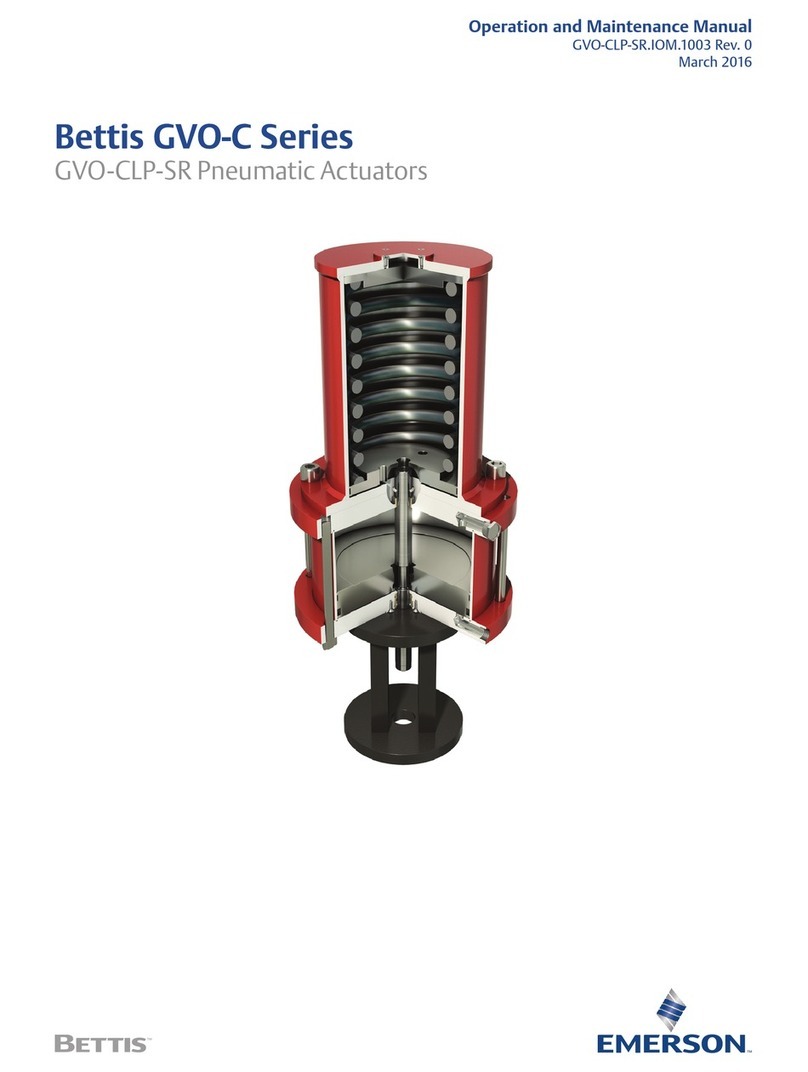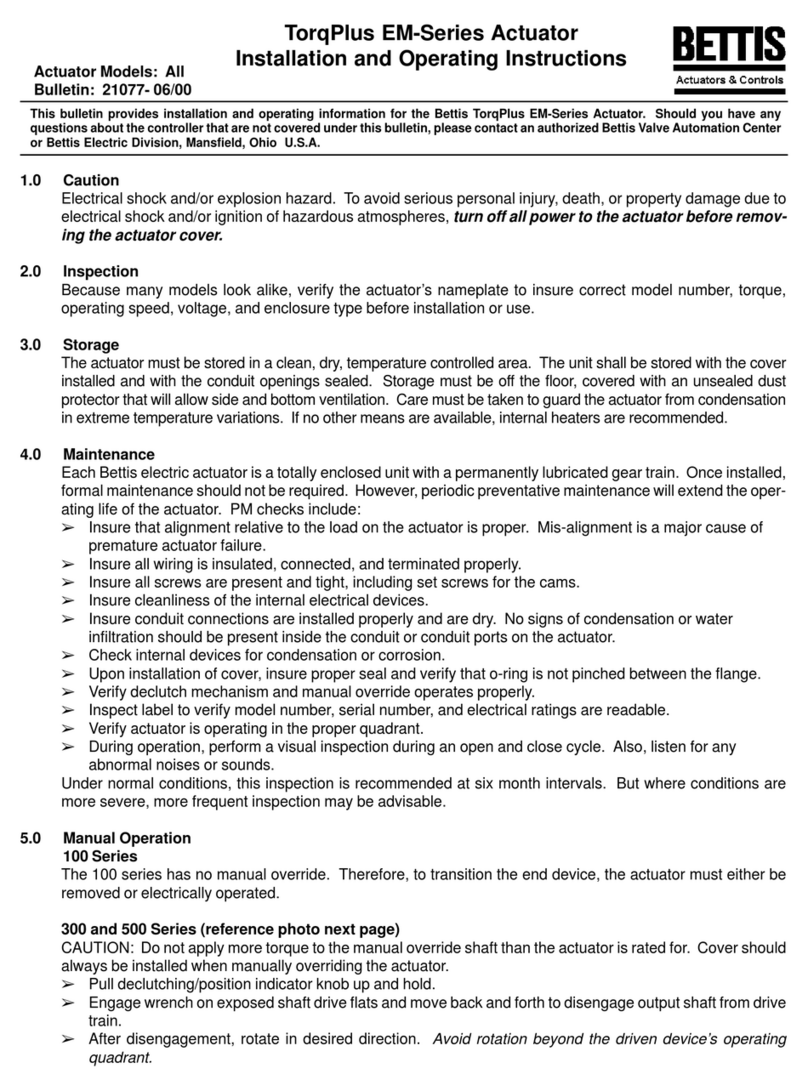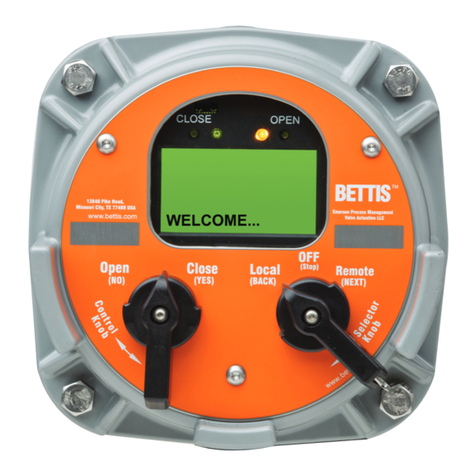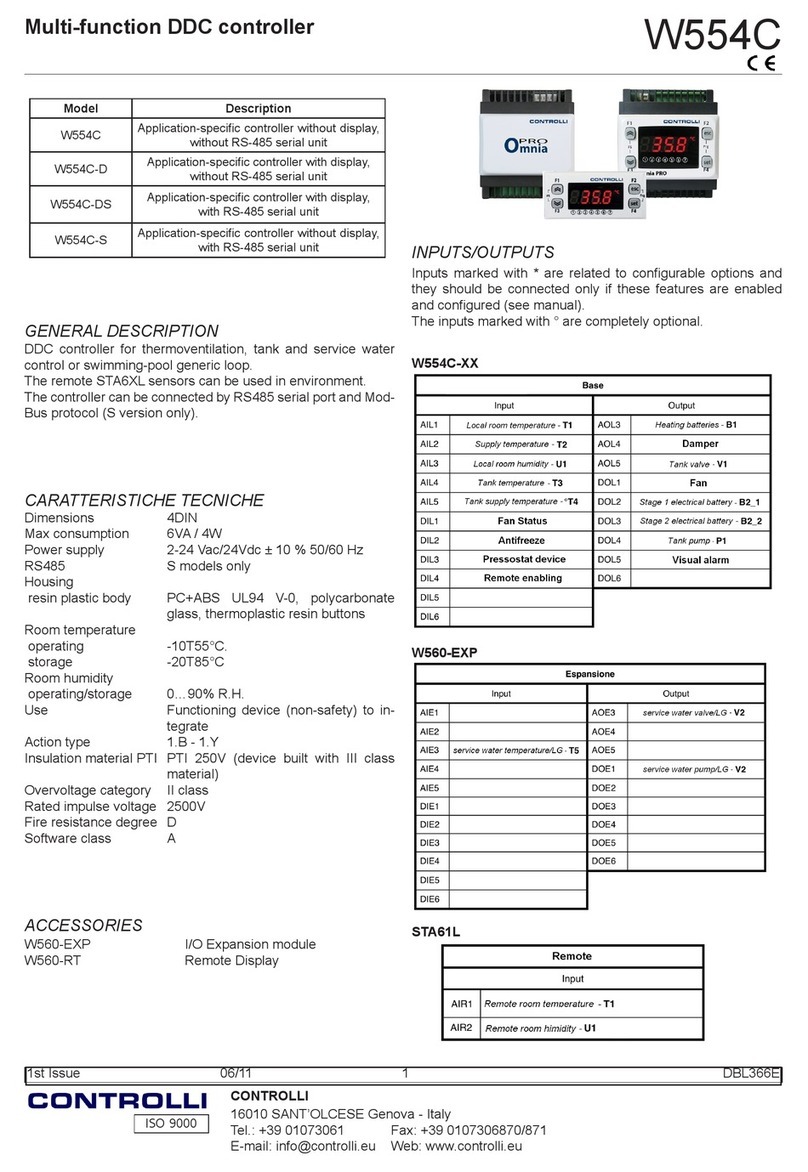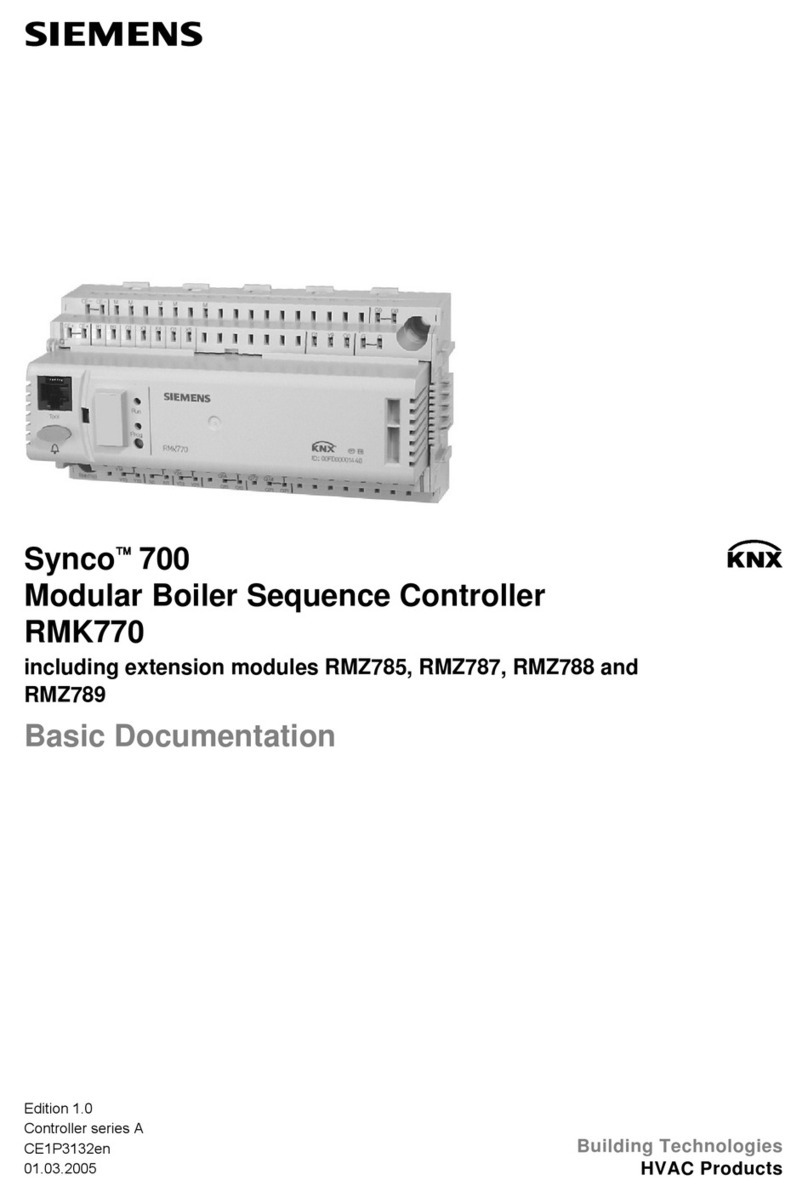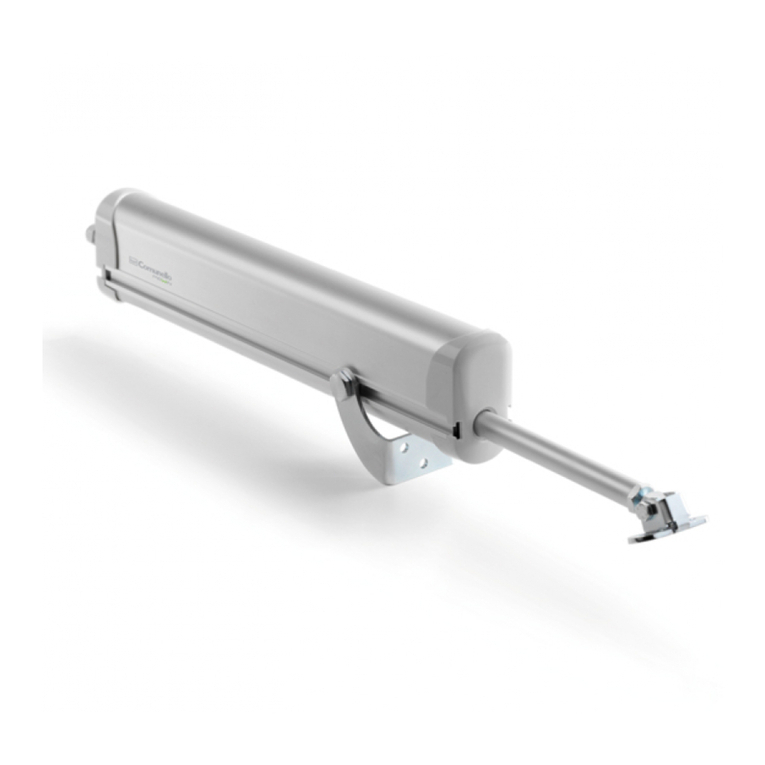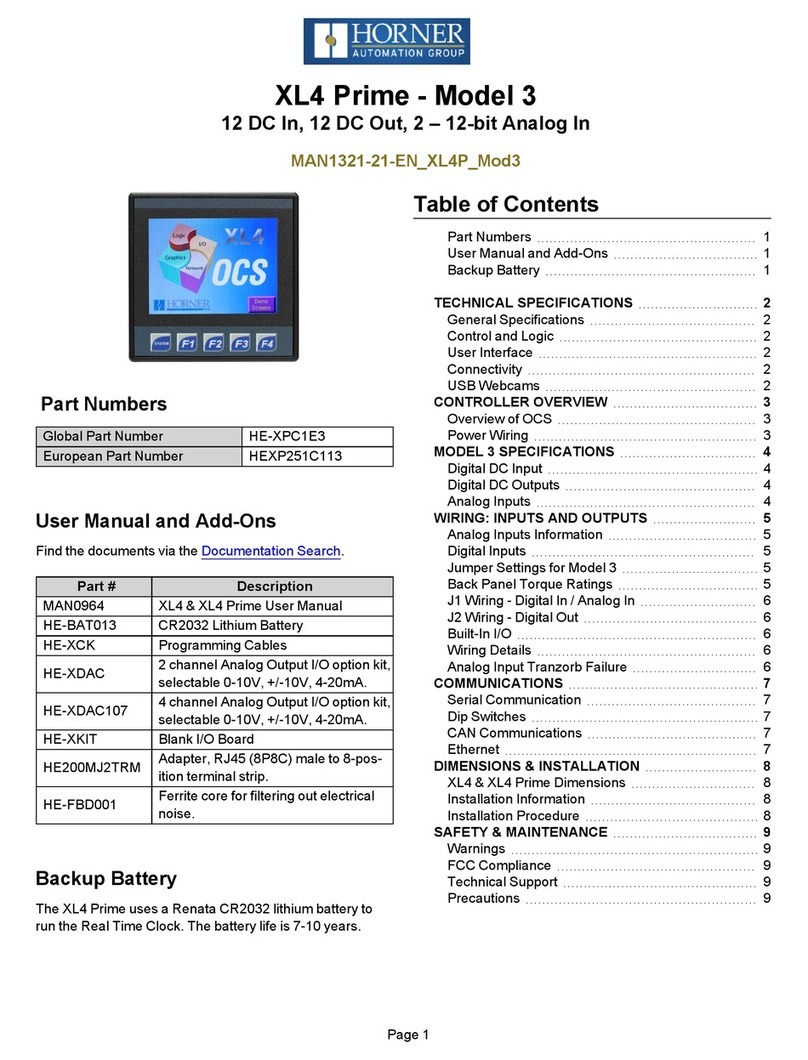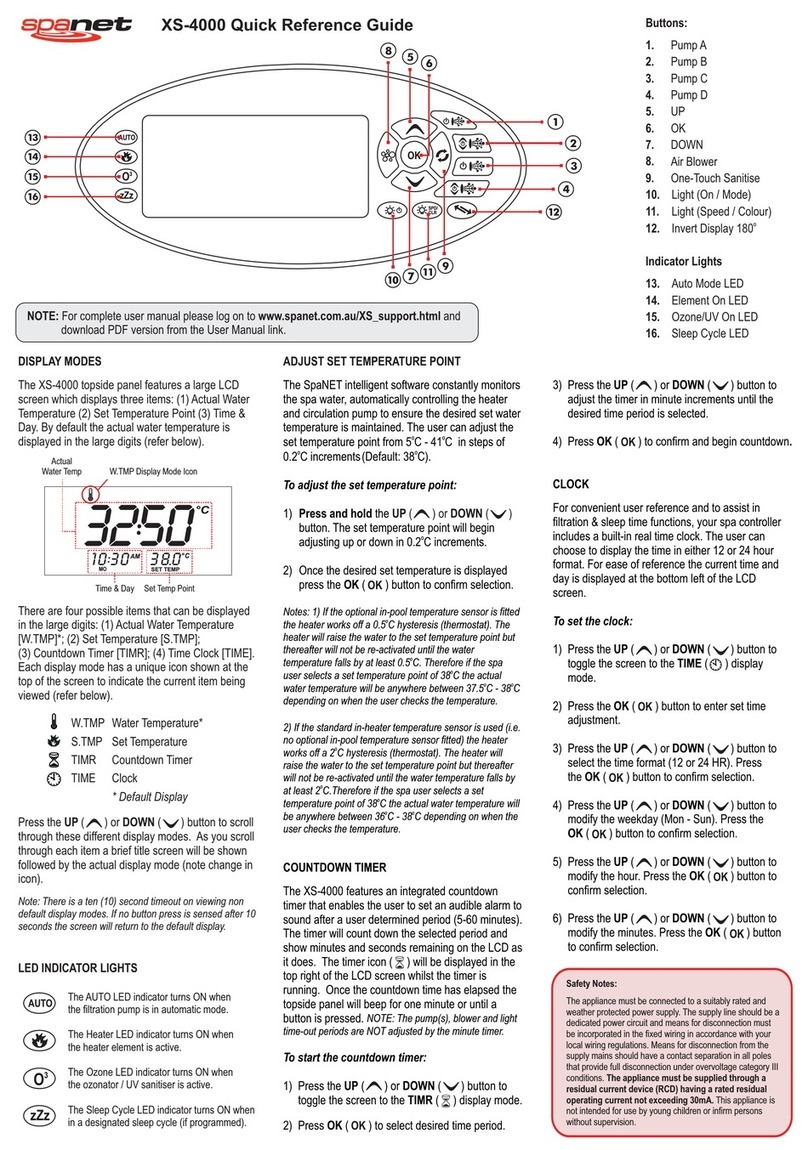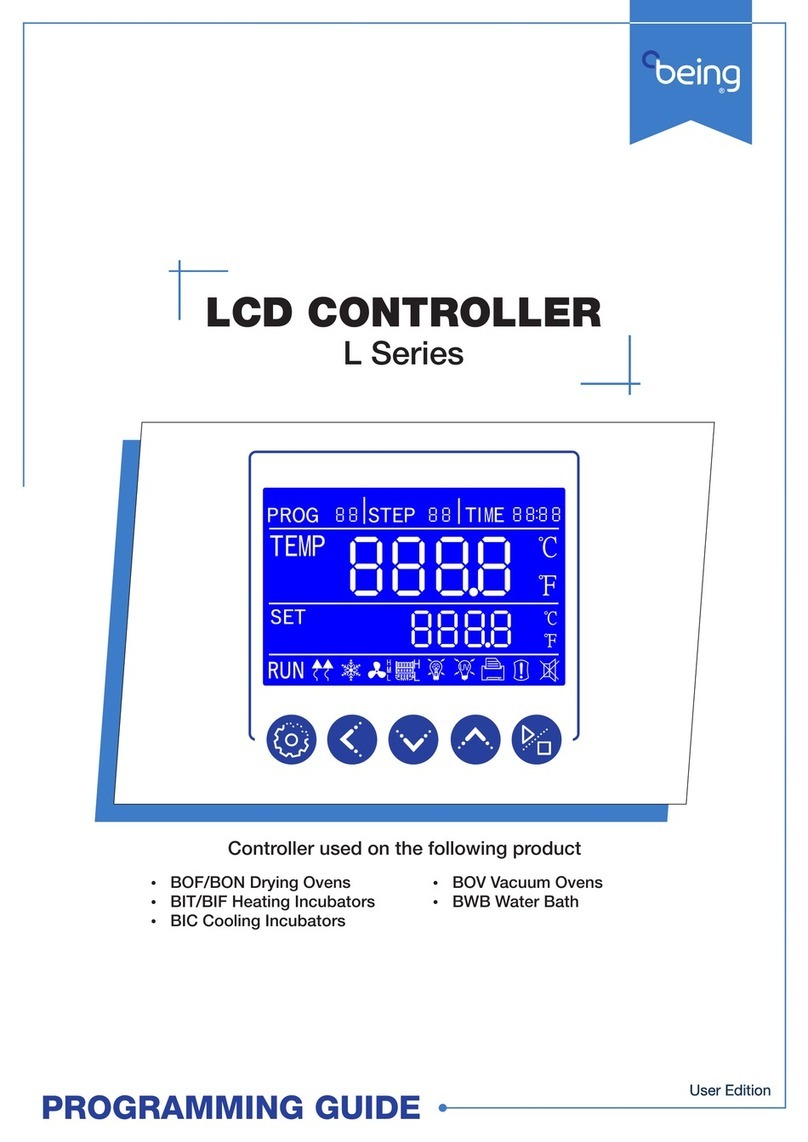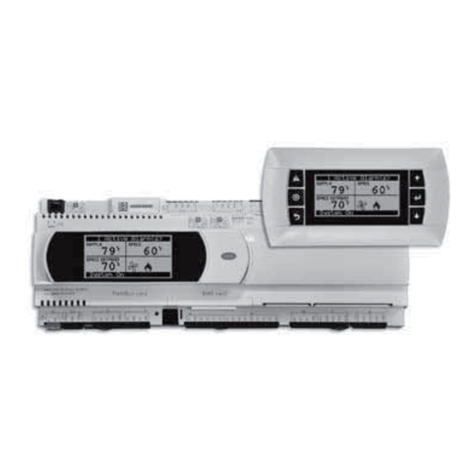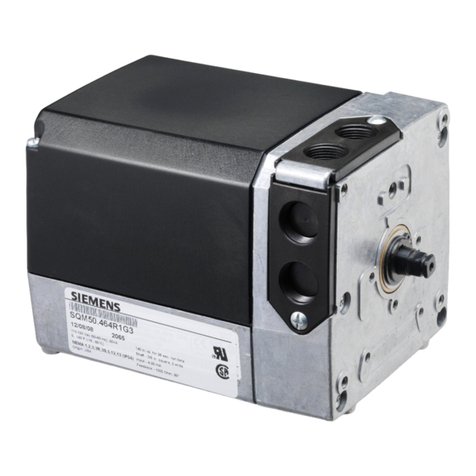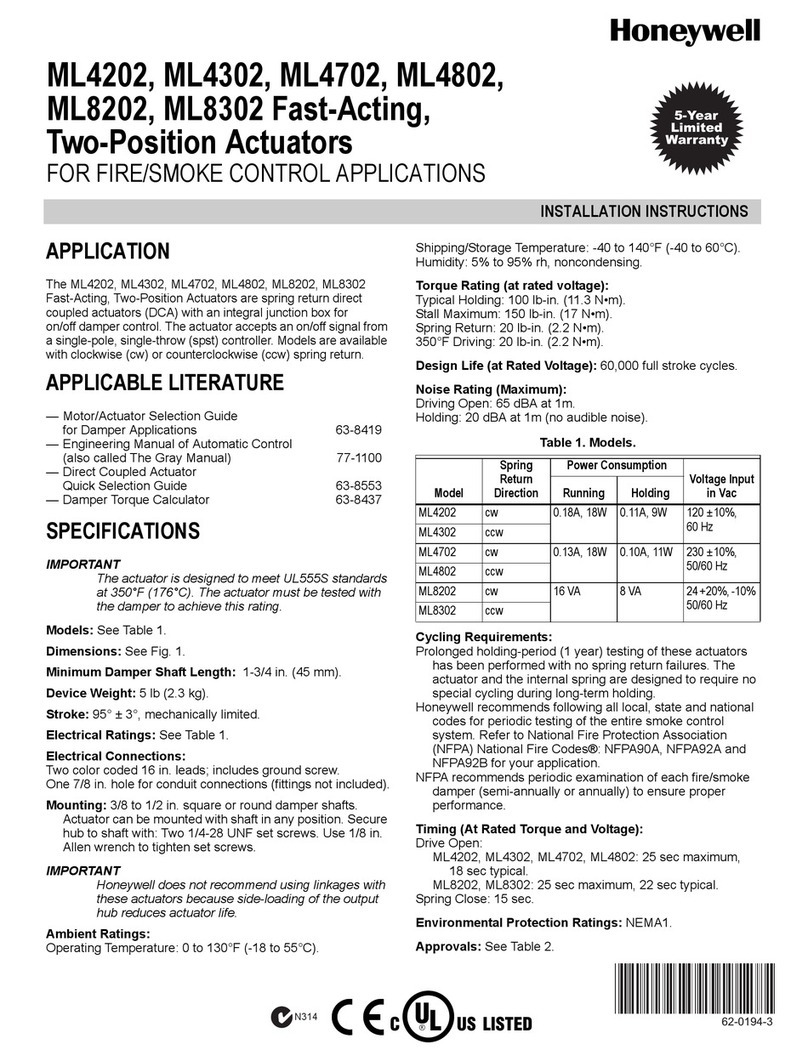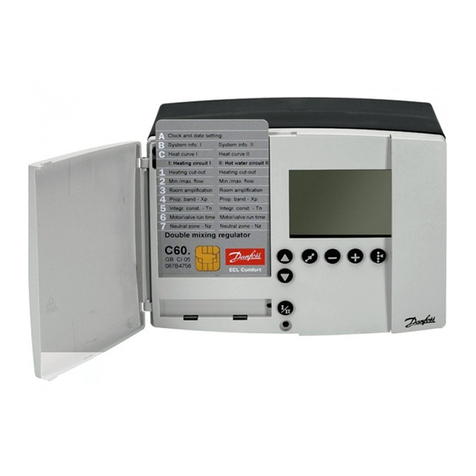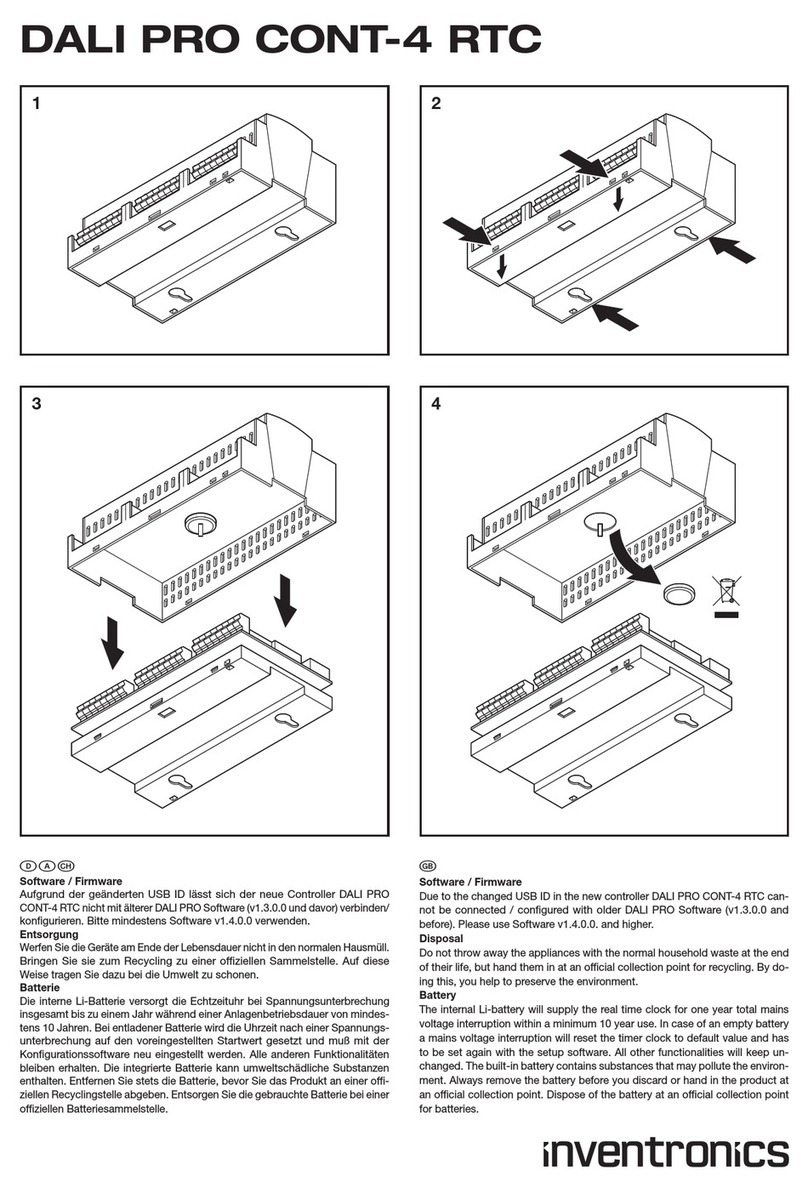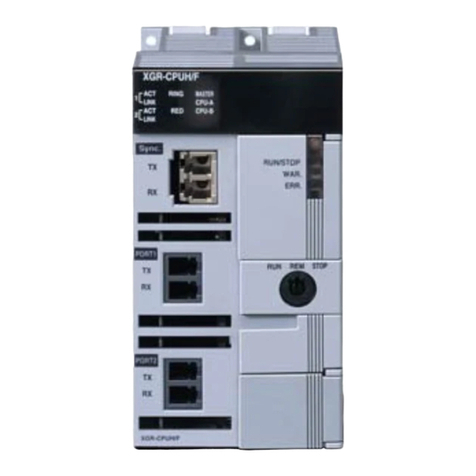Bettis CBAX30 Series Operating instructions

ENGLISH LANUAGE
BETTIS
SERVICE INSTRUCTIONS
DISASSEMBLY AND REASSEMBLY
FOR CBAX30 DOUBLE ACTING
SERIES PNEUMATIC ACTUATORS
PART NUMBER: 137462E
REVISION: "B"
RELEASE DATE: 18 April 2007

Bettis P/N 137462E
Revision "A”
Page 1 of 18
CONTENTS
Page
SECTION 1 - INTRODUCTION ... .......................................................................................................................2
1.1 GENERAL SERVICE INFORMATION ... .............................................................................................2
1.2 DEFINITIONS... ..................................................................................................................................3
1.3 GENERAL SAFETY INFORMATION...............................................................................................
.3
1.4 BETTIS REFERENCE MATERIALS ....................................................................................................3
1.5 SERVICE SUPPORT ITEMS ..............................................................................................................
.3
1.7 GENERAL TOOL INFORMATION .......................................................................................................4
1.8 ACTUATOR WEIGHT... ....................................................................................................................
.4
SECTION 2 - ACTUATOR DISASSEMBLY... .................................................................................................5
2.1 GENERAL DISASSEMBLY .................................................................................................................
.5
2.2 PNEUMATIC CYLINDER DISASSEMBLY ... .....................................................................................
.5
2.3 HOUSING DISASSEMBLY ..............................................................................................................
.6
SECTION 3 - ACTUATOR REASSEMBLY... ..................................................................................................8
3.1 GENERAL REASSEMBLY ...................................................................................................................8
3.2 HOUSING REASSEMBLY ................................................................................................................8
3.3 PNEUMATIC CYLINDER REASSEMBLY ... .....................................................................................11
SECTION 4 - ACTUATOR TESTING ............................................................................................................14
4.1 ACTUATOR TESTING ....................................................................................................................14
SECTION 5 - FIELD CONVERSIONS ... ...........................................................................................................15
5.1 HIGH TEMPERATURE SERVICE (-10 TRIM) ...............................................................................15
5.2 LOW TEMPERATURE SERVICE (-11 TRIM) ... ...............................................................................15
5.3 ADD AN EXTENDED STOP (ES) TO HOUSING ADAPTER (6-10) ...............................................15
5.4 ADD AN EXTENDED STOP (ES) TO CYLINDER END CAP (4-20).............................................16
5.5 ADD AN M3 JACKSCREW TO HOUSING ADAPTER (6-10) .......................................................16
5.6 ADD AN M3 JACKSCREW TO CYLINDER OUTER END CAP (4-20) ........................................17
5.7 ADD M11 OVERRIDE CYLINDERS AND PUMP PACKAGE........................................................18

Bettis P/N 137462E
Revision "A”
Page 2 of 18
SECTION 1 - INTRODUCTION
1.1 GENERAL SERVICE INFORMATION
1.1.1
This service procedure is offered as a guide to enable general maintenance to be
performed on Bettis CBA300 double acting series actuators. The following is a list of
general CBA300 models numbers
MODEL (1) MODEL (1) MODEL (1)
CBA730 CBA730-M3 CBA730-M3HW
CBA830 CBA830-M3 CBA830-M3HW
CBA930 CBA930-M3 CBA930-M3HW
CBA1030 CBA1030-M3 CBA1030-M3HW
(1) Also includes actuator models with –10 and –11 as a suffix
NOTE: When the actuator model number has "-S" as a suffix then the actuator is special and
may have some differences that may not be included in this procedure.
1.1.2 Normal recommended service interval for this actuator series is five years.
NOTE: Storage time is counted as part of the service interval.
1.1.3 This procedure is applicable with the understanding that all electrical power and
pneumatic pressure has been removed from the actuator.
1.1.4 Remove all piping and mounted accessories that will interfere with the disassembly of
the actuator.
1.1.5 This procedure should only be implemented by a technically competent technician who
should take care to observe good workmanship practices.
1.1.6 Numbers in parentheses, ( ) indicate the bubble number (reference number) used on the
Bettis Assembly Drawing and Actuator Parts List.
1.1.7 This procedure is written using the serial number tag side of the housing (1-10) as a
reference and this side will be considered the front side of the actuator. The position
indicator (1-50) area of housing (1-10) will be the top of the actuator.
1.1.8
When removing seals from seal grooves, use a commercial seal removing tool or a
small screwdriver with sharp corners rounded off.
1.1.9 Use a non-hardening thread sealant on all pipe threads.
CAUTION: Apply the thread sealant per the manufacture's instructions.
1.1.10 Bettis recommends that disassembly of the actuator should be done in a clean area on a
workbench.

Bettis P/N 137462E
Revision "A”
Page 3 of 18
1.2 DEFINITIONS
WARNING:
If not observed, user incurs a high risk of severe damage to actuator
and/or fatal injury to personnel.
CAUTION:
If not observed, user may incur damage to actuator and/or injury to
personnel.
NOTE: Advisory and information comments provided to assist maintenance
personnel to carry out maintenance procedures.
M3: Jackscrew or jackscrew assembly.
ES: Extended Stop(s)
1.3 GENERAL SAFETY INFORMATION
1.3.1
Products supplied by Bettis, in its "as shipped" condition, are intrinsically safe if the
instructions contained within this Service Instruction are strictly adhered to and executed by
well trained, equipped, prepared and competent personnel.
WARNING: For the protection of personnel working on Bettis actuators, this
procedure should be reviewed and implemented for safe disassembly and
reassembly. Close attention should be noted to the WARNINGS,
CAUTIONS and NOTES contained in this procedure.
WARNING: This procedure should not supersede or replace any customer’s plant
safety or work procedures. If a conflict arises between this procedure and
the customer’s procedures the differences should be resolved in writing
between an authorized customers representative and an authorized Bettis
representative.
1.4 BETTIS REFERENCE MATERIALS
1.4.1 CBA300 Assembly Drawing use part number 129742.
1.4.2 CBA300-M3HW Assembly Drawing use part number 129744.
1.5 SERVICE SUPPORT ITEMS
1.5.1 Bettis Service Kit.
1.5.2 Commercial leak testing solution.
1.5.3 Non-hardening thread sealant.

Bettis P/N 137462E
Revision "A”
Page 4 of 18
1.6 LUBRICATION REQUIREMENTS
1.6.1 The actuator should be re-lubricated at the beginning of each service interval using
the following recommended lubricants.
NOTE: Lubricants other than those listed in steps 1.6.2 should not be used without prior written
approval of Bettis Product Engineering.
1.6.2 All temperature services
(-50°F to
+350°F)/(-45.5°C to 176.6°C) use Bettis ESL-5
lubricant. ESL-5 lubricant is contained in the Bettis Module Service Kit in tubes and the
tubes are marked ESL-4,5 & 10 lubricant.
1.7 GENERAL TOOL INFORMATION
1.7.1 All threads on CBA series actuators are Inch Unified and NPT.
1.7.2 All tools/Hexagons are American Standard inch.
1.7.3 Suggested tools: Two adjustable wrenches, small standard screwdriver with sharp
edges rounded off, medium size standard screwdriver, external snap ring pliers, drive
ratchet / deepwell socket set and torque wrench (up to 3,000 inch pounds / 339 N-m).
1.8 ACTUATOR WEIGHT
ACTUATOR APPROXIMATE ACTUATOR APPROXIMATE
MODEL WEIGHT (1)
MODEL WEIGHT (1)
LB KG
LB KG
CBA730 130 59 CBA930 155 70.4
CBA730-M3 131 59.4 CBA930-M3 158 71.7
CBA730-M3HW 131.5 59.6 CBA930-M3HW 158.5 71.9
CBA830 140 63.5 CBA1030 170 77.1
CBA830-M3 143 64.9 CBA1030-M3 173 78.5
CBA830-M3HW 143.5 65.1 CBA1030-M3HW 173.5 78.7
NOTES: (1) Weight is for bare actuator without accessories or valve adaptation.

Bettis P/N 137462E
Revision "A”
Page 5 of 18
SECTION 2 - ACTUATOR DISASSEMBLY
2.1 GENERAL DISASSEMBLY
WARNING: It is possible, that the actuator may contain a dangerous gas and/or
liquids. Ensure that all proper measures have been taken to prevent
exposure or release of these types of contaminants before commencing
any work.
CAUTION: Pressure applied to the actuator is not to exceed the maximum operating
pressure rating listed on the actuator name tag.
NOTE: Before starting the general disassembly of the actuator it is a good practice to operate
actuator with the pressure used by the customer to operate the actuator during normal
operation. Notate and record any abnormal symptoms such as jerky or erratic
operation.
2.1.1 Remove all operating pressure from actuator.
NOTE: In place of stop screws the actuator may be equipped with one or two ES (ES =
Extended Stops) or M3/M3HW located on outboard end of housing (1-10) and end cap
(4-20).
2.1.2 Record the settings of stop screw, ES or M3 jackscrews (6-30) and (4-30) before they
are loosened or removed.
2.1.3 To help in correct re-assembly all mating parts should be marked or tagged for ease of
re-assembly, i.e. cylinder to cylinder adapter, cylinder adapter to housing, housing to
torque shaft and housing to housing adapter, etc.
2.2 PNEUMATIC CYLINDER DISASSEMBLY
NOTE: Review Section
2 steps
2.1.1 through
2.1.3 before proceeding with cylinder
disassembly.
2.2.1 Remove hex nut (4-40) as follows: CBA730 through CBA1030 standard end cap stop
screw or extended stop (ES) use step 2.2.1.1. CBA730 through CBA1030 with -M3 or
-M3HW use step 2.2.1.2.
2.2.1.1 CBA730 through CBA1030 end cap stop screw or extended stop screw (ES)
2.2.1.1.1
Loosen and remove hex nut (4-40) and washer (4-90)
from stop screw or ES (4-30) located in end cap (4-20).
2.2.1.1.2 Remove stop screw or ES (4-30) from the end cap (4-20).

Bettis P/N 137462E
Revision "A”
Page 6 of 18
2.2.1.2 CBA730 through CBA1030-M3 or -M3HW
2.2.1.2.1
Remove retainer ring (12-30) and groove pin (12-20) from
optional hex drive hub or from handwheel (12-10).
2.2.1.2.2 Remove optional hex drive hub or handwheel (12-10) from M3
jackscrew (4-30).
2.2.1.2.3 Remove caution tag (12-40) from M3 jackscrew (4-30).
2.2.1.2.4 Loosen and remove hex nut (4-40) from M3 jackscrew (4-30).
NOTE: CBA730 through CBA1030-M3 or M3HW models the M3 jackscrew (4-30) can
not be removed now. The M3 used in these models can be removed later in
this procedure using step 2.2.7.
2.2.2 Remove hex nut (8-20) from the end cap end of center bar (8-10).
2.2.3 Remove outer end cap (4-20) from outboard end of cylinder (4-10).
NOTE: ES (4-30) or stop screw (4-30) does not require removal from end cap (4-20) unless
replacing with a new ES or stop screw.
2.2.4 Slide cylinder (4-10) over piston (4-50) and remove.
2.2.5 Remove piston (4-50) from center bar (8-10).
NOTE: The standard non M3 piston (4-50) is an assembly made up of one roll pin and one yoke
pin; do not attempt to disassemble the piston assembly. The M3 piston (4-50) has two
targets and four drive screws in addition to the roll pin and yoke pin.
2.2.6 On actuator models CBA830, CBA930 and CBA1030 remove cylinder adapter (4-15)
from flange of housing (1-10). Model CBA730 is not equipped with a cylinder adapter
(4-15).
2.2.7 M3 JACKSCREW REMOVAL FROM END CAP (4-20).
2.2.7.1 Remove retainer ring (5-60) from M3 adapter (4-55).
2.2.7.2 Remove M3 adapter (4-55) from end cap (4-20). NOTE: The M3 adapter will
be removed from backside of end cap (4-20) with M3 jackscrew (4-30).
2.3 HOUSING DISASSEMBLY
NOTE: Review Section
2 steps
2.1.1 through
2.1.3 before proceeding with housing
disassembly.
2.3.1 Remove hex nut (6-40) as follows: CBA730 through CBA1030 standard housing adapter
stop screw or extended stop (ES) use step 2.3.1.1. CBA730-M3/M3HW through
CBA1030-M3/M3HW use step 2.3.1.2.

Bettis P/N 137462E
Revision "A”
Page 7 of 18
2.3.1.1 CBA730 through CBA1030 housing adapter stop screw or extended stop screw
(ES)
2.3.1.1.1
Loosen and remove hex nut (6-40) and washer (6-90)
from stop screw (6-30) located in housing adapter (6-10).
2.3.1.1.2 Remove stop screw (6-30) from housing adapter (6-10).
NOTE:
ES (6-30) or stop screw (6-30) does not require removal from the housing
adapter (6-10) unless replacing with a new ES or stop screw.
2.3.1.2 CBA730 through CBA1030-M3/M3HW
2.3.1.2.1
Remove retainer ring (12-30) and groove pin (12-20) from
optional hex drive hub or from handwheel (12-10).
2.3.1.2.2 Remove optional hex drive hub or handwheel (12-10) from M3
jackscrew (6-30).
2.3.1.2.3 Remove caution tag (12-40) from M3 jackscrew (6-30).
2.3.1.2.4 Loosen and remove hex nut (6-40) from M3 jackscrew (6-30).
NOTE: CBA730 through CBA1030-M3/M3HW models the M3 jackscrew (4-30) can not
be removed now. The M3 used in these models can be removed later in this
procedure using step 2.3.10.
2.3.2 Remove center bar (8-10) from housing adapter (6-10).
2.3.3 Remove housing adapter (6-10) from housing (1-10).
2.3.4 Remove the position indicator (1-50) from torque shaft (1-30).
2.3.5 Remove retaining ring (2-90) from torque shaft (1-30).
2.3.6 Remove thrust washer (2-80) and thrust bearing (2-70) from torque shaft (1-30).
2.3.7 Remove the torque shaft (1-30) by pushing it out the bottom of housing (1-10).
2.3.8 Remove yoke key (1-40) from torque shaft (1-30).
2.3.9 Remove yoke (1-20) from housing (1-10).
2.3.10 Actuator equipped with a M3 or M3HW mounted in the housing adapter (6-10) complete
steps 2.3.10.1 and 2.3.10.2.
2.3.10.1 Remove retainer ring (7-60) from M3 adapter (6-55).
2.3.10.2 Remove M3 adapter (6-55) with M3 jackscrew (6-30) from housing
adapter (6-10).

Bettis P/N 137462E
Revision "A”
Page 8 of 18
SECTION 3 - ACTUATOR REASSEMBLY
3.1 GENERAL REASSEMBLY
CAUTION: Only new seals that are still within the seal’s expectant shelf life should be
install into actuator being refurbished.
3.1.1 Remove and discard all old seals and gaskets.
3.1.2
All parts should be cleaned to remove all dirt and other foreign material prior to
inspection.
3.1.3 All parts should be thoroughly inspected for excessive wear, stress cracking, galling and
pitting. Attention should be directed to threads, sealing surfaces and areas that will be
subjected to sliding or rotating motion. Sealing surfaces of the cylinder, torque shaft and
center bar must be free of deep scratches, pitting, corrosion and blistering or flaking
coating.
CAUTION: Actuator parts that reflect any of the above listed characteristics should
be evaluated and replaced with new parts when required.
3.1.4 INSTALLATION LUBRICATION INSTRUCTIONS: Use the correct lubrication as defined
in Section 1 step 1.6.
3.1.4.1 Before installation coat all moving parts with lubricant.
3.1.4.2 Coat all seals with lubricant, before installing into seal grooves.
3.1.5 Torque shaft upper bearing and the lower bearing are not recommended as parts that
require field replacement. Consult Waller Texas Bettis Service Coordinator for “torque
shaft upper or lower bearing” replacement information.
3.1.6 CBAX30 double acting actuator construction as follows:
3.1.6.1 STANDARD CONSTRUCTION - Cylinder (4-10) or cylinder adapter (4-15) and
cylinder (4-10) mounted on the left side of housing (1-10) and housing adapter
(6-10) mounted on the right side of housing (1-10).
3.1.6.2 -S INVERSE CONSTRUCTION - Cylinder (4-10) or cylinder adapter (4-15) and
cylinder (4-10) mounted on the right side of housing (1-10) and the housing
adapter (6-10) mounted on the left side of housing (1-10).
3.2 HOUSING REASSEMBLY
NOTE: Review Section 3 steps 3.1.1 through 3.1.6 before proceeding with housing reassembly.
NOTE: In section 3.2 where the step indicates to "lubricate, coat or apply lubricant",
use
lubricant as identified in Section 1 step 1.6 for lubricating the part being installed.

Bettis P/N 137462E
Revision "A”
Page 9 of 18
NOTE: Actuators equipped with a housing adapter M3 jackscrew (6-30) install M3 per 3.2.1.
Actuators equipped with housing adapter ES or stop screw (6-30) skip step 3.2.1 and
continue assembly at step 3.2.2.
3.2.1 M3 jackscrew installation to housing adapter (6-10).
3.2.1.1 Apply a coating of lubricant to outer diameter and inner diameter threads of M3
jackscrew adapter (6-55).
3.2.1.2 Coat o-ring seal (7-65) with lubricant and install into outer diameter seal groove
located in the M3 jackscrew adapter (6-55).
3.2.1.3 Apply a light coating of lubricant to the threads of M3 jackscrew (6-30).
3.2.1.4 Install and rotate the M3 jackscrew (6-30) into M3 jackscrew adapter (6-55).
NOTE: Rotate the M3 jackscrew into the adapter until the inboard end of the
jackscrew is up against the adapter.
3.2.1.5
Install M3 jackscrew adapter (6-55) with M3 jackscrew (6-30) into housing
adapter (6-10).
3.2.1.6 Install retainer ring (7-60) into exposed outer diameter groove in M3 jackscrew
adapter (6-55).
3.2.1.7 Install o-ring seal (7-30) onto M3 jackscrew (6-30). NOTE: Move the o-ring seal
(7-30) down the M3 jackscrew until it is next to the M3 jackscrew adapter.
3.2.1.8
Install hex nut (6-40) onto M3 jackscrew (6-30). NOTE: Rotate the hex nut
down the M3 jackscrew until it is next to the M3 jackscrew adapter.
3.2.2 Housing Adapter (6-10) ES or stop screw (6-30) installation.
3.2.2.1 Lubricate ES or stop screw (6-30) and install into housing adapter (6-10).
3.2.2.2 Install o-ring seal (7-30) onto ES or stop screw (6-30). NOTE: Move the o-ring
seal (7-30) down the ES or stop screw until it is next to the housing adapter
(6-10).
3.2.2.3 Install washer (6-90) onto ES or stop screw (6-30). NOTE: Push the washer
down the ES or stop screw until it is next to the housing adapter (6-10).
3.2.2.4 Install hex nut (6-40) onto ES or stop screw (6-30). NOTE: Rotate the hex nut
down the ES or stop screw until it is next to the housing adapter (6-10).
3.2.3 Apply a coating of lubricant to the torque shaft holes located on each side of housing
(1-10).
3.2.4 Coat rod wiper seal (2-20) with lubricant and install in the grooves located in the upper
torque shaft “through hole” of housing (1-10). NOTE: The cup of wiper seal will be
installed facing down into the housing.
3.2.5
Coat u-cup seal (2-40) with lubricant and install into the groove located in the lower
torque shaft “through hole” of housing (1-10) - the inner most groove nearest the yoke
(1-20). NOTE: The cup of rod wiper seal will be installed facing into the housing.

Bettis P/N 137462E
Revision "A”
Page 10 of 18
3.2.6 Coat rod wiper (2-60) with lubricant and install into the outer most groove located in the
lower torque shaft “through hole” of housing (1-10). NOTE: The cup of rod wiper will be
installed facing to the out side of housing (1-10).
3.2.7 Apply a generous amount of lubricant to the slots in the arms of yoke (1-20). Coat yoke
(1-20) with lubricant and install into housing (1-10).
3.2.8 Insert the yoke key (1-40) into the slot in the torque shaft (1-30).
3.2.9 Hold the yoke key (1-40) in position and insert the torque shaft (1-30) into and through
housing (1-10) and yoke (1-20).
3.2.10 Install thrust bearing (2-70) onto the upper area of torque shaft (1-30).
3.2.11 Install thrust washer (2-80) onto the upper area of torque shaft (1-30) on top of thrust
bearing (2-70).
NOTE: A new retaining ring (2-90) is provided in the Bettis CBA Service Kit.
3.2.12 Install the new retaining ring (2-90) into the groove located on the upper area of torque
shaft (1-30).
CAUTION: Verify that retaining ring (2-90) is properly seated in the groove of torque
shaft (1-30).
3.2.13 Install position indicator (1-50) onto the top of torque shaft (1-30).
3.2.14 Rotate the torque shaft (1-30) so that the arms of yoke (1-20) point outward.
3.2.15 Coat o-ring seal (5-20) with lubricant and install into inner diameter seal groove located
in the center bar hole of housing adapter (6-10).
3.2.16 Install hex nut (8-20) onto one end of center bar (8-10).
3.2.17 Coat entire length of center bar assembly (8-10) with lubricant including the threads.
3.2.18 Insert center bar assembly (8-10) into the center hole of housing adapter (6-10). Slide
center bar assembly through housing adapter until hex nut (8-20) is flush against the
housing adapter (6-10).
WARNING: Care should be taken during installation of center bar assembly so as to
not scratch it or damage the housing adapter o-ring seal (5-20).
3.2.19 Re-coat center bar assembly (8-10) with lubricant.
3.2.20 Coat o-ring seal (7-10) with lubricant and install onto outer diameter flange located on
housing adapter end of housing (1-10). NOTE: The installation location for o-ring seal
(7-10) is defined in step 3.1.6 under Standard construction and Inverse construction
actuators.
3.2.21 Install housing adapter (6-10), with installed center bar assembly (8-10), onto the
cylinder adapter end of housing (1-10).

Bettis P/N 137462E
Revision "A”
Page 11 of 18
3.3 PNEUMATIC CYLINDER REASSEMBLY
NOTE: Review Section 3 steps 3.1.1 through 3.1.6 before proceeding with cylinder re-assembly.
NOTE:
In section 3.3 where the step indicates to "lubricate, coat or apply lubricant", use
lubricant as identified in Section 1 step 1.6 for lubricating the part being installed.
3.3.1 Coat one o-ring seal (5-10) with lubricant and install onto outer diameter flange located
on cylinder/cylinder adapter end of housing (1-10).
- 3.3.2 Actuators equipped with cylinder adapter (4-15), models CBA830-SR, CBA930-SR and
CBA1030-SR, do steps 3.2.22.1 and 3.2.22.2.
3.3.2.1 Install cylinder adapter
(4-15) onto housing flange, with the stepped outer
diameter, of cylinder adapter (4-15), facing away from housing (1-10).
3.3.2.2 Install one o-seal (5-15) onto stepped diameter of cylinder adapter (4-15).
3.3.3 Coat all areas of piston (4-50) with lubricant.
3.3.4 Coat rod bushing (5-50) with lubricant and install into the internal rod bushing groove
located in the head of piston (4-50).
3.3.5 Coat rod T-seal (5-25) with lubricant and install in the internal seal groove in the head of
piston (4-50).
3.3.6 Coat piston seal (5-40) with lubricant and install into outer diameter seal groove of piston
(4-50).
3.3.7 Coat piston bearing (5-45) with lubricant and install into outer diameter bearing groove of
piston (4-50).
3.3.8
Install two bushings (4-80) onto piston assembly (4-50) - Refer to following drawing
(Figure 1).
FIGURE 1
3.3.9 With the piston head facing away from housing (1-10) install piston assembly (4-50) onto
center bar assembly (8-10).

Bettis P/N 137462E
Revision "A”
Page 12 of 18
3.3.10 Carefully slide piston assembly (4-50) along center bar assembly (8-10) until the yoke
pin engages the slots of yoke (1-20).
CAUTION: Check to determine that both bushings (4-80) are installed between the
arms of yoke (1-20) and the piston assembly (4-50). Refer to Figure 1.
NOTE: While holding the center bar assembly flush against the housing adapter (6-10), push
piston assembly (4-50) into housing (1-10) as far as the piston will travel.
3.3.11 Apply a coating of lubricant to entire bore of cylinder (4-10).
3.3.12 Cylinder (4-10) installation:
3.3.12.1 CBA830, CBA930 and CBA1030 models install the lubricated cylinder (4-10)
over the piston and up-against the o-ring seal on the stepped diameter flange of
cylinder adapter (4-15).
3.3.12.2 CBA730 models install the lubricated cylinder (4-10) over the piston and up-
against the o-ring seal on the flange of housing (1-10).
3.3.13 Coat o-ring seal (5-20) with lubricant and install into inner diameter seal groove located
in the center bar hole of end cap (4-20).
NOTE: Actuators equipped with an end cap M3 jackscrew (4-30) pre-install M3 into end cap
(4-20) per step 3.3.14 and then install pre-assembled end cap into cylinder (4-10) per
step 3.3.15. Actuators equipped with housing adapter ES or stop screw (4-30) skip step
3.3.15 and continue assembly at step 3.3.17.
3.3.14 M3 jackscrew installation to end cap (4-20).
3.3.14.1 Apply a coating of lubricant to outer diameter and inner diameter threads of M3
jackscrew adapter (4-55).
3.3.14.2 Coat o-ring seal (5-65) with lubricant and install into outer diameter seal groove
located in the M3 jackscrew adapter (4-55).
3.3.14.3 Apply a light coating of lubricant to the threads of M3 jackscrew (4-30).
3.3.14.4 Install and rotate the M3 jackscrew (4-30) into M3 jackscrew adapter (4-55).
NOTE: Rotate the M3 jackscrew into the adapter until the inboard end of the
jackscrew is up against the adapter.
3.3.14.5 Install M3 jackscrew adapter (4-55) with M3 jackscrew (4-30) into end cap
(4-20).
3.3.14.6 Install retainer ring (5-60) into exposed outer diameter groove in M3 jackscrew
adapter (4-55).
3.3.14.7 Install o-ring seal (5-30) onto M3 jackscrew (4-30). NOTE: Move the o-ring seal
(5-30) down the M3 jackscrew until it is next to the M3 jackscrew adapter.

Bettis P/N 137462E
Revision "A”
Page 13 of 18
3.3.14.8 Install hex nut (4-40) onto M3 jackscrew (4-30). NOTE: Rotate the hex nut
down the M3 jackscrew until it is next to the M3 jackscrew adapter.
3.3.15 End cap outer diameter seal installation.
3.3.15.1 For CBA830 CBA930 and CBA1030 models install o-ring seal (5-15) onto the
outer diameter of end cap (4-20).
3.3.15.2 For CBA730 models install o-ring seal (5-10) onto the outer diameter of end cap
(4-20).
3.3.16 Install end cap (4-20) onto center bar (8-10) and into cylinder (4-10). Position the end
cap (4-20) so that the inlet port is at the bottom and the ES, cylinder stop screw or M3
jackscrew (4-30) is at the top of the actuator.
WARNING: If step 3.3.17 is not completed as described the center bar o-ring seals
(5-20) may become a source of pressure leakage and cause the actuator to
fail.
3.3.17 Install the second hex nut (8-20) onto the cylinder end of center bar (8-10). Adjust the
two hex nuts (8-20) such that the approximate same number of threads is exposed on
the ends of the center bar (8-10).
WARNING: Do not allow end cap (4-20) to rotate during center bar tightening. The
end cap must maintain the position as described in step 3.3.16. M3
jackscrew must be installed to be in alignment with the target located on
the piston assembly (4-50). If the M3 does not contact the target during M3
adjustments the groove pin (12-20) is subject to failure.
3.3.18 Torque tighten center bar assembly (8-10) to 233 foot pounds / 316 N-m.
3.3.19 End Cap (4-20) ES or stop screw (4-30) installation.
3.3.19.1 Lubricate ES or stop screw (4-30) and install into end cap (4-20).
3.3.19.2 Install o-ring seal (5-30) onto ES or stop screw (4-30). NOTE: Move the o-ring
seal (5-30) down the ES or stop screw until it is next to the end cap (4-20).
3.3.19.3 Install washer (4-90) onto ES or stop screw (4-30). NOTE: Push the washer
down the ES or stop screw until it is next to the end cap (4-20).
3.3.19.4 Install hex nut (4-40) onto ES or stop screw (4-30). NOTE: Rotate the hex nut
down the ES or stop screw until it is next to the end cap (4-20).
3.3.20 M3 hex drive hub or handwheel (12-10) installation as follows:
3.3.20.1 Install hex drive hub (12-10) or handwheel (12-10) onto M3 jackscrews (4-30)
and (6-30). Align the “hole” of the drive hub with the “hole” located in the
outboard end of M3 jackscrew (4-30) and (6-30).

Bettis P/N 137462E
Revision "A”
Page 14 of 18
3.3.20.2 Install caution tag (12-40) onto M3 jackscrews (4-30) and (6-30).
3.3.20.3 Install retainer ring (12-30) and groove pin (12-20) into the hex drive hub (12-10)
or handwheel (12-10).
3.3.21 Adjust both M3 jackscrews (4-30) and (6-30) back to setting recorded in Section 2 step
2.1.2 under General Disassembly. Tighten both M3 jackscrew hex nuts (4-40) and
(6-
40) securely, while holding M3 jackscrews in position.
SECTION 4 - ACTUATOR TESTING
4.1 ACTUATOR TESTING
4.1.1 Leak Test - General - A small amount of leakage may be tolerated. Generally, a small
bubble, which breaks about three seconds after starting to form, is considered
acceptable.
4.1.2
All areas, where leakage to atmosphere may occur, are to be checked using a
commercial leak testing solution.
WARNING: Pressure is not to exceed the maximum operating pressure rating listed
on the serial number tag (20).
4.1.3 All leak testing will use the customer normal operating pressure or the actuator name tag
normal operating pressure (NOP). NOTE: When testing the actuator use a proper
adjusted regulator to apply pressure to the actuator.
4.1.4 Before testing for leaks, apply and release the pressure listed in step 4.1.3 to both sides
of the piston. Repeat this cycle approximately five times. This will allow the new seals
to seek their service condition.
4.1.5 Apply the pressure listed in step 4.1.3 to the housing adapter side of the piston and allow
the actuator to stabilize.
4.1.6 Apply a leak testing solution to the following areas:
4.1.6.1 Cylinder to housing joint on CBA730 or cylinder to cylinder adapter to housing
joints on CBA830, CBA930 and CBA1030 actuator models.
4.1.6.2
On the outboard end of housing adapter (6-10) at the center bar hex nut.
Checks the center bar to housing o-ring seal (5-20).
4.1.6.3 Housing adapter stop screw / ES / M3 jackscrew o-ring seal (7-30).
4.1.6.4 Torque shaft (1-30) to housing (1-10) interface. Checks rod wiper seals (2-20).

Bettis P/N 137462E
Revision "A”
Page 15 of 18
4.1.6.5 End cap (4-20) port "hole". Checks the piston to cylinder seal (5-40) and piston
to center bar seal (5-25).
4.1.6.6 Housing adapter (6-10) to housing (1-10) joint. Checks o-ring seal 7-10).
4.1.7 Apply the pressure listed in step 4.1.3 to the end cap inlet port and allow the actuator to
stabilize.
4.1.8 Apply a leak testing solution to the following areas:
4.1.8.1
Cylinder to end cap joint. Checks o-ring seal (5-10) on CBA730 or checks
o-ring seal (5-15) on CBA830, CBA930 and CBA1030 actuators.
4.1.8.2 Housing adapter (6-10) inlet port hole. Checks the piston to cylinder seal (5-40)
and piston to center bar seal (5-25).
4.1.8.3 End cap ES, stop screw or M3 jackscrew o-ring seal.
4.1.8.4 Remove pressure from pressure inlet port in the end cap (4-20).
4.1.9 If an actuator was disassembled and repaired as a result of this procedure, the above
leakage test must be performed again.
4.1.10 After the actuator is installed back on the valve all accessories should be hooked up and
tested for proper operation and replaced, if found defective.
SECTION 5 - FIELD CONVERSIONS
5.1 HIGH TEMPERATURE SERVICE (-10 TRIM)
5.1.1 Disassemble and reassemble actuator per Sections 1 through Section 4 using new -10
(high temperature) Service Kit.
5.2 LOW TEMPERATURE SERVICE (-11 TRIM)
5.2.1 Disassemble and reassemble actuator per Sections 1 through Section 4 using new -11
(low temperature) Service Kit.
5.3 ADD AN EXTENDED STOP (ES) TO HOUSING ADAPTER (6-10)
NOTE: Prior to disassembly review all of Section 1 Introduction and Section 2 - Actuator
Disassembly, step 2.1 - General Disassembly.

Bettis P/N 137462E
Revision "A”
Page 16 of 18
5.3.1 Stop screw (6-30) removal from housing adapter (6-10).
5.3.1.1
Loosen and remove hex nut (6-40) and washer (6-90) from stop screw (6-30)
located in housing adapter (6-10).
5.3.1.2 Remove stop screw (6-30) from housing adapter (6-10).
NOTE: Prior to reassembly review all of Section 3 - Actuator Reassembly, step 3.1 - General
Reassembly.
5.3.2 ES (6-30) installation into housing adapter (6-10).
5.3.2.1 Lubricate ES (6-30) and install into housing adapter (6-10).
5.3.2.2 Install o-ring seal (7-30) onto ES (6-30). NOTE: Move the o-ring seal (7-30)
down the ES until it is next to housing adapter (6-10).
5.3.2.3 Install washer (4-90) onto ES or stop screw (4-30). NOTE: Push the washer
down the ES or stop screw until it is next to the housing adapter (6-10).
5.3.2.4 Install hex nut (6-40) onto ES (6-30). NOTE: Rotate the hex nut down the ES
until it is next to housing adapter (6-10).
5.4 ADD AN EXTENDED STOP (ES) TO CYLINDER END CAP (4-20)
NOTE: Prior to disassembly review all of Section 1 Introduction and Section 2 - Actuator
Disassembly, step 2.1 - General Disassembly.
5.4.1 Stop screw (4-30) removal from end cap (4-20).
5.4.1.1 Loosen and remove hex nut (4-40) and washer (4-90) from stop screw (4-30)
olocated in end cap (4-20).
5.4.1.2 Remove stop screw (4-30) from end cap (4-20).
5.4.2 ES (4-30) installation.
5.4.2.1 Lubricate ES (4-30) and install into end cap (4-20).
5.4.2.2 Install o-ring seal (5-30) onto ES (4-30). NOTE: Move the o-ring seal (5-30)
down the ES until it is next to the end cap (4-20).
5.4.2.2 Install washer (4-90) onto ES (4-30). NOTE: Move the washer (4-90) down
the ES until it is next to the end cap (4-20).
5.3.2.3 Install hex nut (4-40) onto ES (4-30). NOTE: Rotate the hex nut down the ES
until it is next to the end cap (4-20).

Bettis P/N 137462E
Revision "A”
Page 17 of 18
5.5 ADD AN M3 JACKSCREW TO HOUSING ADAPTER (6-10)
NOTE: This Section can also be used to add an M3 to the cylinder end cap (4-20) at the same time as
the M3 is added to the housing adapter (6-10). When a M3 is only being installed into housing
adapter (6-10) skip step 3.3.14 during installation. For Single M3 addition to cylinder end cap
(4-20) use Section 5.6.
5.5.1 Prior to disassembly review all of Section 1 Introduction.
5.5.2 Disassemble the actuator per Section 2.1 - General Disassembly, Section 2.2 -
Pneumatic Cylinder Disassembly steps 2.2.2 through 2.2.5 and Section 2.3 - Housing
Disassembly steps 2.3.2 and 2.3.3.
5.5.3
Prior to actuator re-assembly review all of Section 3.1 - General Re-assembly, 3.2 -
Housing Re-assembly and 3.3 - Pneumatic Cylinder Re-assembly.
5.5.4 If new M3 housing adapter (6-10) is not pre assembled with the M3 then assemble M3 to
the housing adapter (6-10) per Section 3.2 step 3.2.1.
WARNING: The M3 cannot be installed on a standard CBA actuator unless the M3
targets are installed on the piston assembly as shown in Figure Number 2.
If the M3 is operated with a piston that does not have a target the groove
pin (12-20) is subject to failure.
5.5.5
Add the M3 targets to the piston assembly (4-50) per Figure Number 2 - M3 piston
targets.
FIGURE NUMBER 2
5.5.6 Reassemble the actuator per Section 3.2 steps 3.2.14 through 3.2.20, Section 3.3 steps
3.3.1 through to the end of Section 4 - Actuator Testing.

Bettis P/N 137462E
Revision "A”
Page 18 of 18
5.6 ADD AN M3 JACKSCREW TO CYLINDER OUTER END CAP (4-20)
5.6.1 Prior to disassembly review all of Section 1 - Introduction.
5.6.2 Disassemble the actuator per Section 2.1 - General Disassembly, Section 2.2 -
Pneumatic Cylinder Disassembly steps 2.2 .2 through step 2.2.5.
5.6.3
Prior to actuator re-assembly review all of Section 3.1 - General Re-assembly, 3.2 -
Housing Re-assembly and 3.3 - Pneumatic Cylinder Re-assembly.
5.6.4 If new M3 outer end cap (4-20) is not pre assembled with the M3 then assembly M3 to the
outer end cap (4-20) per Section 3.3 step 3.3.14.
WARNING: The M3 cannot be installed on a standard CBA actuator unless the M3
targets are installed on the piston assembly as shown in Figure Number 2.
If the M3 is operated with a piston that does not have a target the groove
pin (12-20) is subject to failure.
5.6.5
Add the M3 targets to the piston assembly (4-50) per Figure Number 2 - M3 piston
targets.
5.6.6 Install the assembled M3 outer end cap (4-20) per Section 3.3 steps 3.3.1 through 3.3.13
and steps 13.3.15 through to the end of Section 4 - Actuator Testing.
5.7 ADD M11 OVERRIDE CYLINDERS AND PUMP PACKAGE
5.7.1 Consult Factory for further information.
ECN DATE REV BY * DATE
Released May 2002 A COMPILED L.Ramirez 18 April 2007
19527 April 2007 B CHECKED C.Ross 18 April 2007
APPROVED D.McGee 18 April 2007
*Signatures on file Bettis Actuator & Controls, Waller, Texas

This manual suits for next models
12
Table of contents
Other Bettis Controllers manuals
